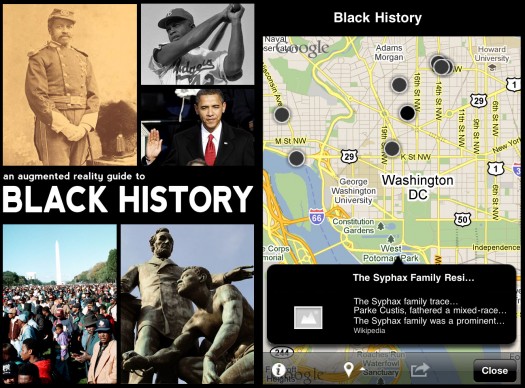Mobile Black History Project Expands to Nine Cities

Spotted…
This is one in an on-going series of stories about innovation in community news.
Click here to read more.
In the weeks after Retha Hill launched the first iteration of her Mobile Black History Project in January 2011, the response was overwhelmingly positive. “Anecdotally, I have lots of people emailing me saying it’s fantastic,” she said, “and wanting to contribute content to it.”
The project connects mobile users with information about nearby locations of significance in black history. It accomplishes this using augmented reality, an emerging technology that adds a layer of virtual information over a camera view.

Retha Hill, creator of Mobile Black History Project.
J-Lab selected Hill’s project in 2010 to receive start-up funds as a New Media Women Entrepreneur award winner.Currently, the Mobile Black History Project app covers nine major cities, including Washington, D.C., Baltimore, Philadelphia, Boston, Richmond, Charleston, Chicago, Phoenix and New Orleans. She is expanding to Cleveland, Cincinnati, Nashville, Detroit and New York City over the next few weeks, with the hopes of one day expanding into every major city.
Here’s how it works: A user in downtown Washington, D.C., opens the Layar applicationon his or her smartphone and searches for the “Black History” layer. Once added, the mobile device uses GPS to determine the user’s location and begins to recognize points of interests such as buildings or open spaces where black history occurred in the camera view. That allows the program to direct the user to nearby items of interest and provide context, historic images and video.
Walking around Georgetown, the app points out that a few steps to the south of the area’s waterfront was the site of one of the nation’s largest attempted slave uprisings. Or, a short walk away on S Street, the user can find the Benjamin O. Davis House, home to the father-and-son duo that were the first and second black generals in the U.S. Armed Forces.
“I’m always looking for ways to engage people of color in technology,” Hill said recently of her motivation to create the Mobile Black History app. Hill is also director of the New Media Innovation Lab at Arizona State University.
She noted that communities of color are often left out of the cutting edge innovations in technology. “But I’ve always been one to see if there’s a way to get people excited about technology by making sure there’s content of interest to them.”
Hill is hoping to add a crowd-sourcing component but has determined she needs to create a mechanism for verification of each contribution.
As a history buff, Hill takes her research seriously. For the Chicago version, she recently added the weeks-long riots that took place in Chicago in 1919 but needed to pinpoint the location where it began. After searching old Chicago Tribune articles and magazine pieces, she finally discovered the place where a young black boy began swimming and drifted into a “whites only area” triggering a deadly attack and used that as her marker. “Local lore is one thing. It’s another to say ‘this is where the very thing happened.’”
“The hardest thing for me has been monetizing this,” Hill said. If all goes according to plan, she will begin to partner with news organizations and tourist bureaus for sponsorship. “But I just have not really been able to find a good guide for how you set a CPM (cost per 1,000 impressions) and ROI (return on investment) on mobile apps.”
Hill has used the $12,000 award from the McCormick Foundation New Media Women Entrepreneurs project to pay the developers and some freelance writers to contribute content.
“It was just enough for me to get the proof of concept done, to get it to be a reality. I couldn’t have done it without the funding from J-Lab,” she said.
An application specifically designed for the iPhone is expected in April 2011.
To use the Layar overlay, download the Layar app on your mobile device just as you would any other app. Then search for layers and enter “Black History”. Because the application is location-specific, you need to be near points of interest for information to appear. In the app’s settings you can expand the radius to include items from a broader area.
Follow along with Retha’s blog as she continues to develop the Mobile Black History Project.
